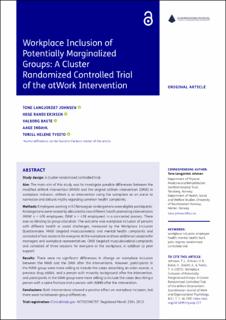| dc.contributor.author | Johnsen, Tone Langjordet | |
| dc.contributor.author | Eriksen, Hege Randi | |
| dc.contributor.author | Baste, Valborg | |
| dc.contributor.author | Indahl, Aage | |
| dc.contributor.author | Tveito, Torill Helene | |
| dc.date.accessioned | 2023-10-24T08:37:21Z | |
| dc.date.available | 2023-10-24T08:37:21Z | |
| dc.date.created | 2023-08-09T08:25:38Z | |
| dc.date.issued | 2023 | |
| dc.identifier.citation | Johnsen, T. L., Eriksen, H. R., Baste, V., Indahl, A., & Tveito, T. H. (2023). Workplace Inclusion of Potentially Marginalized Groups: A Cluster Randomized Controlled Trial of the atWork Intervention. Scandinavian Journal of Work and Organizational Psychology, 8(1), 1–16. | en_US |
| dc.identifier.issn | 2002-2867 | |
| dc.identifier.uri | https://hdl.handle.net/11250/3098270 | |
| dc.description.abstract | Study design: A cluster randomized controlled trial.
Aim: The main aim of this study was to investigate possible differences between the modified atWork intervention (MAW) and the original atWork intervention (OAW) in workplace inclusion. atWork is an intervention using the workplace as an arena to normalize and debunk myths regarding common health complaints.
Methods: Employees working in 93 Norwegian kindergartens were eligible participants. Kindergartens were randomly allocated to two different health promoting interventions (MAW n = 406 employees, OAW n = 438 employees) in a concealed process. There was no blinding to group allocation. The outcome was workplace inclusion of persons with different health or social challenges, measured by the Workplace Inclusion Questionnaire. MAW targeted musculoskeletal and mental health complaints and consisted of two sessions for everyone at the workplace and two additional sessions for managers and workplace representatives. OAW targeted musculoskeletal complaints and consisted of three sessions for everyone at the workplace, in addition to peer support.
Results: There were no significant differences in change on workplace inclusion between the MAW and the OAW after the interventions. However, participants in the MAW group were more willing to include the cases describing an older worker, a previous drug addict, and a person with minority background after the intervention, and participants in the OAW group were more willing to include the cases describing a person with a spine fracture and a person with ADHD after the intervention.
Conclusions: Both interventions showed a positive effect on workplace inclusion, but there were no between-group differences. | en_US |
| dc.language.iso | eng | en_US |
| dc.relation.uri | https://sjwop.com/articles/10.16993/sjwop.157 | |
| dc.rights | Navngivelse 4.0 Internasjonal | * |
| dc.rights.uri | http://creativecommons.org/licenses/by/4.0/deed.no | * |
| dc.title | Workplace Inclusion of Potentially Marginalized Groups: A Cluster Randomized Controlled Trial of the atWork Intervention | en_US |
| dc.type | Peer reviewed | en_US |
| dc.type | Journal article | en_US |
| dc.description.version | publishedVersion | en_US |
| dc.rights.holder | © 2023 The Author(s). | en_US |
| dc.source.pagenumber | 1-16 | en_US |
| dc.source.volume | 8 | en_US |
| dc.source.journal | Scandinavian Journal of Work and Organizational Psychology | en_US |
| dc.source.issue | 1 | en_US |
| dc.identifier.doi | https://doi.org/10.16993/sjwop.157 | |
| dc.identifier.cristin | 2165762 | |
| cristin.ispublished | true | |
| cristin.fulltext | original | |
| cristin.qualitycode | 1 | |

